
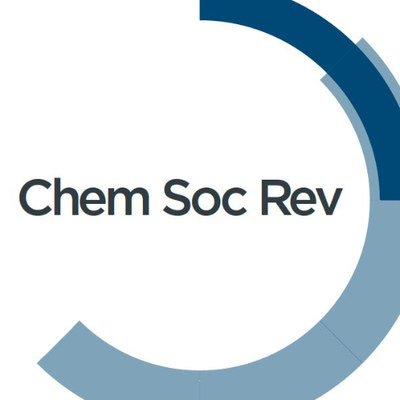 ChemSocRev (Chemical Society Reviews) is a leading journal published by the Royal Society of Chemistry, featuring high-impact, authoritative, and highly readable review articles. Since its inception in 1947 as the Quarterly Review of the Chemical Society, ChemSocRev has published many influential review papers over the past 70 years, growing to become one of the most impactful and recognized journals in the field of chemical sciences, consistently ranking among the top in various impact metrics across all scientific journals.
ChemSocRev (Chemical Society Reviews) is a leading journal published by the Royal Society of Chemistry, featuring high-impact, authoritative, and highly readable review articles. Since its inception in 1947 as the Quarterly Review of the Chemical Society, ChemSocRev has published many influential review papers over the past 70 years, growing to become one of the most impactful and recognized journals in the field of chemical sciences, consistently ranking among the top in various impact metrics across all scientific journals.
Surface-enhanced Raman spectroscopy (SERS) originated from an accidental scientific discovery in the 1970s, which caused a sensation with its million-fold signal enhancement effect. Despite facing skepticism regarding its feasibility during its development and application, it has continuously achieved breakthroughs, ultimately evolving into a powerful analytical tool with ultra-high sensitivity and resolution, becoming one of the earliest branches of nanoscience and plasmonic photonics. This 99-page review encapsulates half a century of research, providing insights to readers from five dimensions through a narrative approach focusing on methodological innovations:
1. SERS discovery history — A systematic elaboration of the discovery of the anomalous enhancement effect, revealing its physical and chemical mechanisms, constructing a framework of experimental and theoretical foundations, clarifying its intrinsic connection with nanoscience and plasmonic photonics, and highlighting the collective wisdom of pioneers in exploring unknown territories.
2. Stages of SERS development — Summarizing the fifty-year evolution of SERS into four key stages: the flourishing period (mid-1970s to mid-1980s), the exploratory low period (mid-1980s to mid-1990s), the nanotechnology-driven period (mid-1990s to mid-2010s), and the ongoing development period (mid-2010s to present).
3. SERS technology lineage — In-depth exploration of the expansion of the SERS technology system, including unique contributions and development trajectories of branches such as single-molecule SERS, tip-enhanced Raman spectroscopy (TERS), and shell-isolated nanoparticle-enhanced Raman spectroscopy (SHINERS).
4. Key breakthroughs in innovative methods — A systematic analysis from a methodological perspective of innovative ideas to enhance detection sensitivity, spatiotemporal resolution, substrate universality, quantitative capability, and mechanistic understanding, promoting SERS to become a universal analytical technology.
5. Inheritance and promotion of scientific spirit — Distilling the valuable experiences of pioneers and innovators, actively embracing emerging technologies, proactively collaborating across disciplines, and boldly turning the “impossible” into reality; persistently seeking breakthroughs during periods of research low, as opportunities often favor the prepared.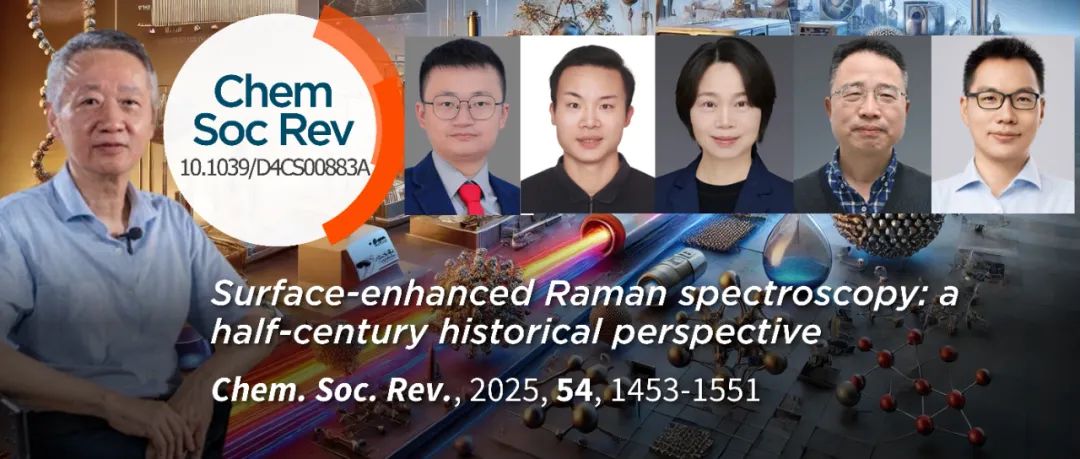 Xiamen UniversityQun TianAcademician is the corresponding author of this review,Jun YiAssociate Professor, Jimei UniversityEn-Ming YouAssociate Professor andXiamen UniversityRen HuSenior Engineer are co-first authors, gathering the collective wisdom of forty of the most active research groups from China, the USA, Canada, the UK, Germany, Switzerland, Spain, Japan, South Korea, India, Singapore, and New Zealand.⬇️Review Article
Xiamen UniversityQun TianAcademician is the corresponding author of this review,Jun YiAssociate Professor, Jimei UniversityEn-Ming YouAssociate Professor andXiamen UniversityRen HuSenior Engineer are co-first authors, gathering the collective wisdom of forty of the most active research groups from China, the USA, Canada, the UK, Germany, Switzerland, Spain, Japan, South Korea, India, Singapore, and New Zealand.⬇️Review Article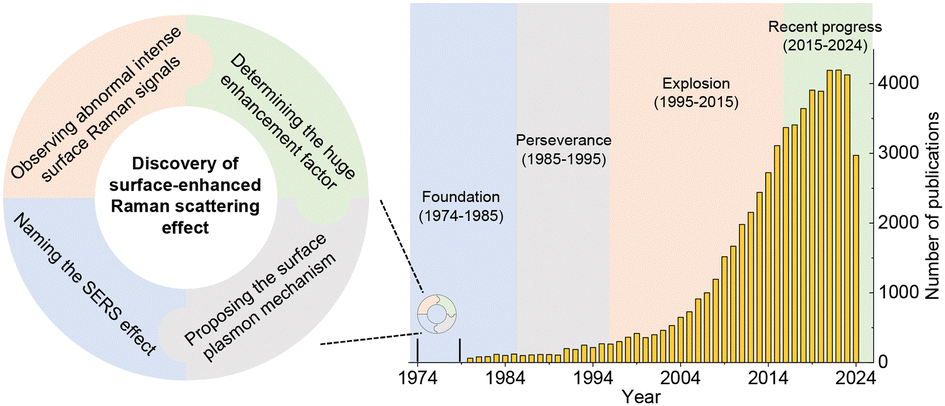
- Surface-enhanced Raman spectroscopy: a half-century historical perspective
Jun Yi, En-Ming You, Ren Hu, De-Yin Wu, Guo-Kun Liu, Zhi-Lin Yang, Hua Zhang, Yu Gu, Yao-Hui Wang, Xiang Wang, Hao Ma, Yang Yang, Jun-Yang Liu, Feng Ru Fan, Chao Zhan, Jing-Hua Tian, Yu Qiao, Hailong Wang, Si-Heng Luo, Zhao-Dong Meng, Bing-Wei Mao, Jian-Feng Li, Bin Ren, Javier Aizpurua, Vartkess Ara Apkarian, Philip N. Bartlett, Jeremy Baumberg, Steven E. J. Bell, Alexandre G. Brolo, Louis E. Brus, Jaebum Choo, Li Cui, Volker Deckert, Katrin F. Domke, Zhen-Chao Dong, Sai Duan, Karen Faulds, Renee Frontiera, Naomi Halas, Christy Haynes, Tamitake Itoh, Janina Kneipp, Katrin Kneipp, Eric C. Le Ru, Zhi-Peng Li, Xing Yi Ling, Jacek Lipkowski, Luis M. Liz-Marzán, Jwa-Min Nam, Shuming Nie, Peter Nordlander, Yukihiro Ozaki, Rajapandiyan Panneerselvam, Jürgen Popp, Andrea E. Russell, Sebastian Schlücker, Yang Tian, Lianming Tong, Hongxing Xu, Yikai Xu, Liangbao Yang, Jianlin Yao, Jin Zhang, Yang Zhang, Yao Zhang, Bing Zhao, Renato Zenobi, George C. Schatz, Duncan Graham and Zhong-Qun Tian* Chem. Soc. Rev., 2025, 54, 1453-1551
This review article is open access, please click the “Read the original” link at the end of the article, or copy the following link to open the original in your browser:https://doi.org/10.1039/D4CS00883A Some text interpretations are sourced from:https://chem.xmu.edu.cn/info/1445/31264.htm
Introduction
In 1974, when Fleischmann et al. first reported the potential-dependent SERS spectra, they did not realize that this was an anomalous surface-enhanced spectroscopic signal. Over the past half-century, SERS has repeatedly encountered misinterpretations, widespread skepticism, and developmental bottlenecks, yet it has continuously innovated and gained resilience, becoming a highly sensitive molecular detection and analysis tool. The emergence of SERS has brought revolutionary breakthroughs to traditional Raman spectroscopy technology: by significantly enhancing signal detection sensitivity, it has achieved single-molecule detection capabilities for the first time, greatly expanding the application boundaries of molecular spectral analysis and having a profound impact.
This article, focusing on methodology, divides the development of SERS over the past 50 years into four key stages: the foundational period (mid-1970s to mid-1980s), the low and ongoing exploratory period (mid-1980s to mid-1990s), the nanotechnology-driven explosive period (mid-1990s to mid-2010s), and recent advancements (mid-2010s to present). Throughout this development process, SERS has been closely linked with advancements in nanoscience and plasmonic photonics, with the establishment of its experimental and theoretical foundations reflecting the collective wisdom and contributions of many pioneering researchers. Meanwhile, the development of SERS technology has continuously spawned new branches, such as tip-enhanced Raman spectroscopy (TERS) and shell-isolated nanoparticle-enhanced Raman spectroscopy (SHINERS), which not only enrich the connotation of the SERS family but also provide new solutions to overcome developmental bottlenecks, significantly expanding the universality of materials, morphologies, and molecules, promoting SERS to become a multifunctional technology with broad application prospects.
The unique development path of SERS over half a century profoundly illustrates the essence of scientific progress: major breakthroughs often stem from the persistent exploration of scientists and the synergistic effect of interdisciplinary collaboration. Along this development path, pioneers have demonstrated valuable qualities: actively embracing emerging technologies, courageously breaking traditional boundaries; promoting cross-field collaboration, transforming seemingly impossible ideas into reality; and persistently exploring until breakthroughs are achieved, even during periods of technological downturns, as opportunities often favor the prepared.
Key Points of the Review
- IntroductionIntroduction
 ▲ A timeline of the historical progress of the Raman effect, SERS, and related revolutionary technological breakthroughs.
▲ A timeline of the historical progress of the Raman effect, SERS, and related revolutionary technological breakthroughs.
- The foundation of surface-enhanced Raman spectroscopy (mid-1970s–mid-1980s)The foundational period of surface-enhanced Raman spectroscopy (SERS) (mid-1970s to mid-1980s)
Theoretical prediction and experimental discovery of the Raman effect
The theoretical prediction and experimental discovery of the Raman effect
Why was surface Raman spectroscopic research initiated in the 1970s?
Why did surface Raman spectroscopy research begin in the 1970s?
Why was the birth of SERS rooted in an electrochemical system?
Why was SERS born in an electrochemical system?
First observation of SERS spectra of molecules adsorbed on electrode
First observation of SERS spectra of molecules adsorbed on electrodesFirst determination of the surface-enhanced Raman effectFirst establishment of the surface-enhanced Raman effectFoundation of enhancement mechanisms of SERS
Foundation of the enhancement mechanisms of SERS
In 1974, Fleischmann, Hendra, and McQuillan from the University of Southampton observed unusually high-quality Raman spectra of pyridine molecules adsorbed on electrochemically roughened silver (Ag) electrodes during their exploration of electrochemical Raman spectroscopy. This unexpected result shocked young assistant professor Van Duyne at Northwestern University, as it was deemed impossible to measure the signal based on textbook calculations of the Raman spectral intensity of surface molecules. He and his student Jeanmaire meticulously reproduced the experiment and calculated that the effective Raman scattering cross-section of pyridine adsorbed on the Ag surface was an astonishing million times higher than that of similar molecules in solution. Their paper, after being rejected by multiple journals for over two years due to strong skepticism from reviewers regarding the proposed surface enhancement effect, was finally published in 1977. In the same year, Creighton and Albrecht from Kent University also reported similar results. Various mechanisms were proposed to explain this anomalous enhancement of surface Raman scattering. The widely accepted surface plasmon enhancement mechanism was first proposed by Moskovits from the University of Toronto in 1978. Subsequently, in 1979, Van Duyne officially named this effect surface-enhanced Raman scattering (SERS).
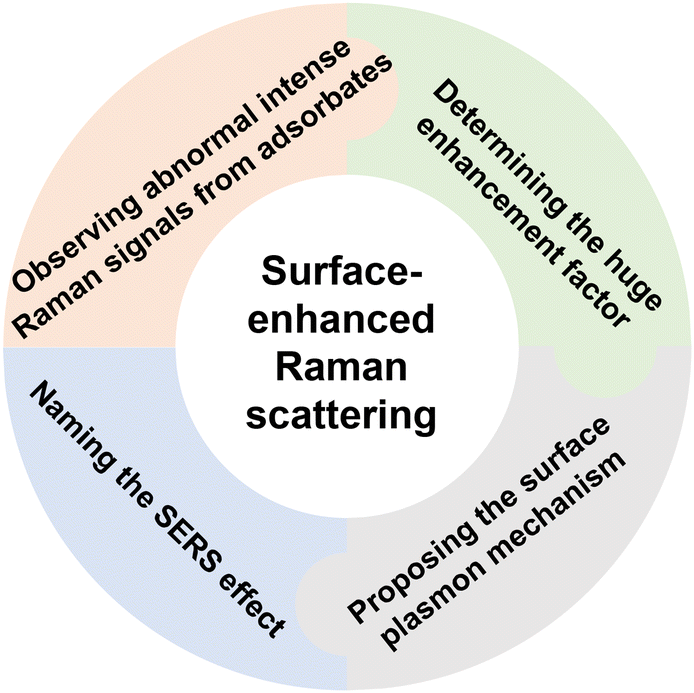
- Original Figure 1. Four key elements in the discovery process of the surface-enhanced Raman scattering (SERS) effect
In the first decade of SERS, its theoretical framework (including concepts such as hotspots with highly concentrated electric fields and TERS, which surpasses optical diffraction limit resolution) gradually took shape, laying a solid foundation for subsequent development. Although the era of nanoscience had not yet arrived, and the precise quantification of the SERS effect and complete revelation of the nature of SERS activity had not been achieved, the achievements made in the first decade laid the cornerstone for the continuous progress over the next forty years, guiding its development and inspiring further exploration.
-
The decade of persistent exploration (mid-1980s–mid-1990s) The decade of persistent exploration (mid-1980s to mid-1990s)
The “borrowing SERS activity” strategy
“Borrowing SERS activity” strategy
Explorations on bio-SERS and electrochemical-SERS
Research explorations on bio-SERS and electrochemical-SERS
Interfacial water as an unusual target by SERS
Unconventional SERS research targeting interfacial water
The second decade of SERS faced significant challenges and setbacks. A series of experimental and theoretical issues, including the narrow application scope of SERS, poor data reproducibility, and complex mechanisms, led to skepticism within the fields of Raman spectroscopy, materials, and surface science, as well as the entire academic community. Many research groups gradually left the SERS field due to difficulties in obtaining funding, and some young scholars faced job insecurity. However, some scientists persevered in their efforts to break through seemingly impossible barriers, developing the “borrowing SERS activity” strategy and continuing to explore in areas such as bio-SERS and electrochemical SERS (e.g., interfacial water). They believed that although the SERS effect had not been fully understood, its extremely high surface sensitivity held great potential and should not be easily abandoned. Breakthroughs might eventually occur, although no one could predict when.
- SERS breakthroughs enabled by advancements in nanoscience (mid-1990s–mid-2010s)Breakthroughs in SERS driven by nanoscience (mid-1990s to mid-2010s)▲ (a) Representative SERS active substrates and (b) the evolution and milestones related to the development of Raman instruments.
The significant rise in SERS
The resurgence of SERS research
Demonstration of single-molecule sensitivity in SERS
Reports of single-molecule sensitivity in SERS experiments
Key methods of SERS since the mid-1990s
Key technologies in SERS since the mid-1990s
Key methods for high sensitivity
Key technologies for enhancing SERS sensitivity
Key methods for high spatial and temporal resolution
Key technologies for improving SERS spatial and temporal resolution
Key methods for expanding the generalities of SERS substrate materials and morphologies
Key technologies for expanding the universality of SERS substrate materials and morphologies
Key methods for evaluation of enhancement factors
Key methods for evaluating enhancement factors
Key methods for quantitative analysis
Key technologies for quantitative analysis using SERS
In 1986, the Nobel Prize in Physics was awarded for electron microscopy and scanning tunneling microscopy, which gradually ushered in a flourishing development of nanoscience in the 1990s, indirectly promoting innovation in the SERS field and allowing it to be reborn. During this period, advancements in nanomaterial synthesis, processing, and characterization significantly enhanced the understanding of SERS active substrates, expanding them from rough gold and silver electrode systems to finely controllable nanoparticles and surface systems. The report of SERS with single-molecule sensitivity in 1997 was a milestone event of this period, but it was also confirmed by dual-analyte SERS experiments after years of skepticism. Over the two decades driven by nanoscience, SERS technology has significantly advanced in terms of high sensitivity, high temporal/spatial resolution, and the universality of materials and morphologies, thanks to continuous innovations in related methodologies.
- Advances in recent years (mid-2010s–mid-2020s)Recent advancements (mid-2010s to mid-2020s)
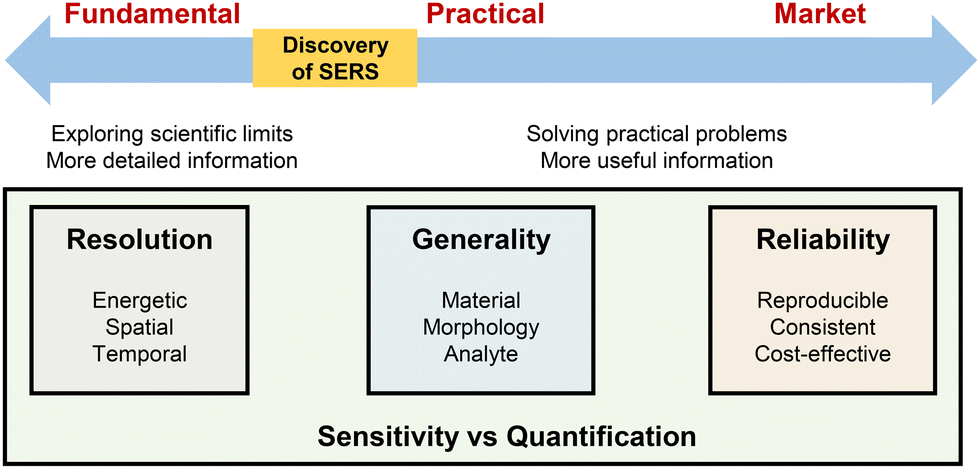 Original Figure 51. Different development directions and focuses of SERS since its inception
Original Figure 51. Different development directions and focuses of SERS since its inception
TERS in the atomistic near field (ATERS)
Atomic-scale near-field TERS (ATERS)
SERS on weakly adsorbed molecules and interfacial structures
Applications of SERS in weakly adsorbed molecules and interfacial structures
Quantitative analysis
New advancements in SERS for quantitative analysis
Development of SERS methods in bio research
Advancements in SERS technology in biological research
The rapid development of nanoscience and the urgent needs of disciplines such as analytical science, surface science, electrochemistry, and biology have triggered a second wave of SERS research. However, it should be noted that although the number of published articles has exponentially increased since the millennium, this is largely due to the lowered barriers to nanomaterial synthesis techniques and increased accessibility of SERS methods. Most of the published papers have only used SERS as an easily accessible characterization technique or analytical method, rather than achieving breakthroughs in SERS method innovation and commercialization, which has made SERS seem to stagnate in recent years.
Therefore, actively embracing emerging sciences, developing new methods, and breaking through the status quo are crucial, with three breakthrough paths: deeper fundamental research, broader application technologies, and wider instrument commercialization. Looking ahead, the development direction of SERS technology is clear: it must integrate cutting-edge technologies such as artificial intelligence to address issues of batch consistency and stability of SERS substrates, expand quantitative analysis capabilities, and accelerate practical applications and commercialization in fields such as medical diagnostics, food safety, and environmental protection.
-
Summary and inspirations from the SERS historySummary and insights from the development history of SERS
Collective contribution in opening a new scientific field
Collective contributions in pioneering a new scientific fieldChallenge to conventional wisdom and transforming the impossible into realityChallenging conventional wisdom and turning the “impossible” into reality
Learning from the premature and discovery of SERS
As one of the oldest branches of nanoscience, SERS was born about 20 years ahead of its time
Entering a new field as early as possible
Entering emerging research fields as early as possibleSignificant discoveries are often accompanied by initial incorrect explanationsMajor scientific breakthroughs are often accompanied by initial misinterpretations
Perseverant searching in times of low tide may lead to triumph
Persisting in exploration during research downturns may lead to revolutionary breakthroughsProactively embracing and adopting new science and technologyActively embracing new sciences and technologies to drive innovation in disciplinesHigh level and high-quality interdisciplinary collaborationHigh-level and high-quality interdisciplinary collaboration is key
Comprehensive methodology is the key driver for major advancements
A comprehensive and systematic methodology is the core driver for significant progressBoldly venture out of the comfort zone of your familiar research to tackle more complex challengesBravely step out of your comfort zone to tackle more challenging research topics
Reflecting on the entire journey of SERS discovery and development, it is particularly interesting that its discovery occurred about twenty years ahead of its time. Without the pioneers’ bold challenges to conventional wisdom and textbooks, the discovery of SERS might not have happened in the mid-1970s. If the discovery of SERS had begun during the prosperous period of nanoscience in the mid-1990s, its development would have been easier, as SERS is fundamentally a branch of nanoscience, with its sensitivity and spectral characteristics heavily reliant on nanostructures.
Thus, it is easier to understand why SERS faced significant challenges and underwent a difficult and complex journey before the mid-1990s. However, the unique development history of SERS also highlights that it is one of the oldest branches of plasmon-enhanced spectroscopy, plasmonic photonics, and even broader nanoscience. Therefore, the story of SERS discovery is unique and inspiring compared to many other scientific fields. The collective contributions of all pioneers and trailblazers during the foundational period of SERS deserve our utmost respect and learning.
The corresponding author of this review, Academician Qun Tian, was fortunate to enter the field of SERS research in 1983 as a doctoral student of Dr. Fleischmann and to meet all the pioneers. We draw valuable spirits from the accidental discovery and arduous development of SERS and distill the profound insights and creativity of the pioneers into ten key inspirations, including: courageously challenging conventional wisdom; collective contributions in pioneering a new scientific field; entering emerging research fields as early as possible; major scientific breakthroughs often accompanied by initial misinterpretations; persisting in exploration during research downturns may lead to revolutionary breakthroughs; actively embracing new sciences and technologies to drive innovation in disciplines, hoping to inspire the next generation to continue advancing, bravely breaking out of their comfort zones, and tackling more challenging scientific research topics.
This review is not only a systematic summary of the past 50 years of development in the SERS field but also a strategic reflection on the future development of SERS. The fifty-year development journey strongly proves that scientific innovation requires not only accidental discoveries and flashes of insight but also a persistent spirit of exploration. As the saying goes, “opportunity always favors the prepared,” only through continuous innovation in persistence can we seize the opportunities for technological development. SERS, as a vibrant and powerful analytical tool, will continue to write new chapters in future scientific explorations.
Author Profiles
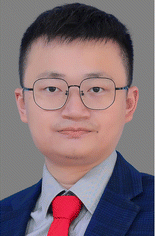
Jun Yi
Xiamen University
Associate Professor at the School of Electronic Science and Technology, Xiamen University. He obtained his Bachelor’s degree in Physics from the University of Science and Technology of China in 2012 and his Ph.D. in Physical Chemistry from Xiamen University in 2019, under the supervision of Professor Qun Tian. From 2019 to 2021, he conducted postdoctoral research in Professor Xiang Zhang’s group at the University of California, Berkeley. He joined Xiamen University in 2021, with research interests including surface-enhanced Raman spectroscopy (SERS), plasmonic photonics, and nanospectroscopy.

En-Ming You
Jimei University
Associate Professor at the School of Marine Information Engineering, Jimei University. He graduated with a Bachelor’s degree in Physics from Nanjing University in 2015 and obtained his Ph.D. in Physical Chemistry from Xiamen University in 2020, under the supervision of Professor Qun Tian. After graduating, he continued postdoctoral research in the same group. He joined Jimei University in 2023, with research interests including plasmon-enhanced infrared/Raman spectroscopy, nano-infrared spectroscopy, and imaging technology.
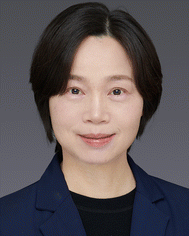
Ren Hu
Xiamen University
Senior Engineer at the National Key Laboratory of Surface and Interface Chemistry, Xiamen University. He obtained his Ph.D. in Physical Chemistry from Xiamen University in 2005 and then conducted postdoctoral research at the Sino-French International Joint Laboratory of Nanobiology and Chemistry at Xiamen University (with collaborative supervisors Christian Amatore and Qun Tian). He joined Xiamen University in 2011 as a Senior Engineer. His research interests include micro/nano electrochemistry and spectroelectrochemistry.
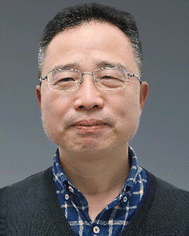
De-Yin Wu
Xiamen University
Graduated from Shaanxi Normal University in 1992 with a Bachelor’s degree; obtained his Ph.D. in Physical Chemistry from Sichuan University in 1998. After graduation, he conducted postdoctoral research in Professor Qun Tian’s group, focusing on SERS theory. He is currently a professor in the Department of Chemistry at Xiamen University (since 2006). His research areas include the theory of surface-enhanced Raman spectroscopy, spectroelectrochemistry, and plasmon-mediated chemical reactions, with approximately 250 published papers.

Guo-Kun Liu
Xiamen University
Professor at the School of Environment and Ecology, Xiamen University. He graduated from Suzhou University with a Bachelor’s degree in Chemical Education; obtained his Ph.D. in Physical Chemistry from Xiamen University in 2006, under the supervision of Professor Qun Tian. After graduation, he conducted postdoctoral research at Hunan University (with Professor Ruqin Yu), Cornell University (with Professor Peng Chen), and the National Institute of Standards and Technology (NIST) (with Dr. Thomas Moffat). He joined Xiamen University in 2015, with primary research interests in the multi-field applications of SERS.

Qun Tian
Xiamen University
Graduated from Xiamen University in 1982 with a Bachelor’s degree; obtained his Ph.D. from the University of Southampton in 1987, under the supervision of Professor Martin Fleischmann (FRS), focusing on electrochemical SERS. He became a professor at Xiamen University in 1991, was elected as an academician of the Chinese Academy of Sciences in 2005, and was selected as a Fellow of the Royal Society of Chemistry. He has served as the president of the International Society of Electrochemistry (ISE) (2019-2020), deputy editor of Chem. Soc. Rev. (2012-2024), and a member of the advisory boards of over ten international journals. He has received multiple scientific awards, including the Raman Lifetime Award. His research areas include SERS and SHINERS, spectroelectrochemistry, nanochemistry, plasmonic photonics, and catalysis.